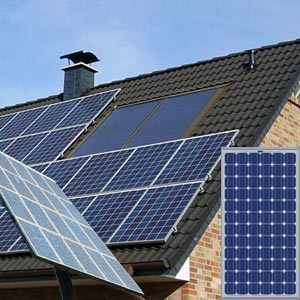Residential Thin Film Solar Panels

Solar panels are environmentally friendly and clean means of collecting solar energy, renewable energy from the sun. It is estimated that on any bright sunny day approximately 1000 watts of energy per square meter of the planet's surface can be collected from the sun. This can easily power multitude of homes and offices.
Photovoltaic Cells
The term solar panels was traditionally applied to any flat solar thermal collector, such as hot water or air panel used to heat water and air. But these days 'solar panel' refers to photovoltaic module which can be described as an 'assembly of solar cells' which is used to generate electricity. The panels are typically flat and available in various heights and widths. Solar panels are widely being used in residential, commercial, institutional and industrial applications.
Photovoltaic (PV) is the particular field of technology and research that is related to the application of solar cells for converting solar energy into electricity directly. The term 'photovoltaic' is of Greek origin, with 'photo' meaning 'light' and 'voltaic' meaning 'electric.' The term photovoltaic can be technically described as 'unbiased operating mode of a photodiode' and current is due to the transduced light energy. The photons of light knock the electrons into higher state of energy to create electricity.
Usually solar panels include solar cells designed to convert light energy from a wide range of light frequencies into electricity for maximum efficiency. In a photovoltaic panel, the solar cells are electrically interconnected. Solar panels can either be connected in parallel or series depending upon the design or objective of use. Serial connections give optimal voltage, whereas the latter gives optimal current source capability.
Infrared solar cells render greater efficiency with the ability of the panels to function at nights at well. Heat, cold, moisture, wind and snow can irrevocably damage the solar cells which have to be protected from the elements to enable them to work. They have to be transported efficiently and stored properly.
Solar panels types
The market is flooded with several varieties of solar panels. The most common among them is 'silicon crystal' panel. Silicon panels are efficient and work for five to seven years of power production. Thin film solar array is another newly emerging technology. Here the solar panels are made utilizing lesser material when compared to solar panels by traditional methods. However, they are deemed as less efficient than the established crystal arrays. By and large there are two major types of technology that is used in solar panels:
Rigid thin film: solar cell panels are created directly onto a laminated sheet of glass
Flexible thin film :the cells are created on a flexible substrate such as an insulating polymer film.
Thin film solar cell: These are slimmer and require lesser materials and energy for construction. They are therefore economical though construed as less efficient. Instead of using hard crystalline silicon, the technology involved is to put extremely thin films of photovoltaic material onto a thin layer of backing. One means of doing this is through 'solar ink'.
Here the photovoltaic material is dissolved into a solution and then printed into ink. Printing can be done on thin layers of plastic, metal, or fabric facilitating mass production of solar panels at high speeds and lower costs.
Amorphous silicon solar cell: The lifetime of amorphous cells is much shorter than that of crystalline cells. However, the efficiency of amorphous solar cells is rated as 6 to 8 %. The ideal light source of amorphous solar cells is fluorescent lamps as the spectral response reaches maximum at wavelengths of blue light.
Highly refined purified silicon crystals are used to make solar cells and used in the manufacture of integrated circuits and computer chips called wafer silicon. However, the cost of silicon solar cells is prohibitory; coupled with their complex production complex.
Crystalline silicon solar cells: It is estimated that the highest efficiency of silicon solar cells is around 23% extendable up to 30% dependent upon wavelength and semiconductor material. These are almost widely used although their efficiency is limited due to various factors such as self losses caused by metal contacts on the upper side of the solar cell, solar cell resistance and solar radiation reflectance on the upper side of a solar cell.
Cadmium telluride (CdTe) solar cells: The sunlight is absorbed and converted into electricity by a semiconductor layer using cadmium telluride thin film. This technology is the first and only thin film photovoltaic technique that surpasses crystalline silicon photovoltaic in cost efficiency. Cadmium telluride is gaining rapid acceptance as the most utilized solar cell material in the world.
Organic/ polymer solar cells: This is an organic solar cell or organic chemistry photovoltaic also called plastic solar cell. Electricity is produced from sunlight using polymers. This is relatively a new technology. The performance of organic polymer devices depends much on absorbing as much light as possible converting the photon energy into free electrons and minimizing resistance in the process.
Polymer cells in comparison to silicon solar cells are lighter in weight. They are also inexpensive and disposable, flexible and can be customized at molecular level.
Crystalline silicon solar cells: This is convenient to use and yields stable solar cells with good efficiencies. There are two types of crystalline silicon used in the manufacturing processes. The first is monocrystalline silicon which is produced by slicing wafers from a high purity single crystal boule. The other is multicrystalline silicon which is made by sawing a cast block of silicon into bars and then wafers. The current trend is toward multicrystalline technology. Laser grooved, buried grid contacts are used for maximum light absorption and efficient production in monocrystalline silicon technology.
Another ideal material for top cell absorber is protocrystalline silicon of multi junctions like tandem cells. While short wavelength light is almost completely absorbed in the photocrystalline top cell absorber without being transmitted on the other hand long wavelength light is low loss transmitted into the bottom cell absorbed which if composed of amorphous silicon absorbs most of the red part of the solar spectrum and allows proper current matching in the complete solar cell.
Nanocrystalline silicon which has made rapid progress in the last couple of years is a quality photoactive layer for solar cells. 10% efficiency is achieved by deposition of crystalline to amorphous transition, at high pressure depletion condition; by taming of ion energy and grading of the material growth at reduced unwanted dopant incorporation.
Residential solar panels
These days many are looking for alternative energy sources to power their homes and offices. Photovoltaic panels probably are the best solution.
Solar power can be deployed in homes as it is especially affordable. In order to encourage the photovoltaic panel technology, the Federal and the State government in the US have passed legislation on a feed-in tariff designed to enable people to invest in their own solar power generation. The government also provides large tax discounts and benefits to those installing residential solar panels.
Apart from the savings on energy costs, solar panels are environment friendly and easy to use. Homes in the sunny regions of the US can most benefit from solar power which is a cost effective option. With the increase in the number of residential solar panels, there would be enormous amount of energy saved as well.
Again, solar panels need not be used to power the entire home; instead smaller rooms and outdoor gardens or greenhouses can be applied with solar panels. Probably, a pool could be well heated during winter months or a driveway at night with solar power.
Whereas buying new residential solar panels would cost a fortune, it would be wise to go in for used solar panels which could cost lesser and only about 10% of efficiency would have been lost even after twenty odd years.
Interestingly, the largest solar panel in the world is under construction in the south of Portugal. This 52,000 photovoltaic module, 11 megawatt facility covering a 60 hectare region is estimated to produce electricity for 21,000 households.
Residential solar roof panels
Solar roof panels for homes are extremely durable with a life expectancy of thirty to forty years. Solar roof panels refer to a particular type of solar panel which is meant to be placed on the roof of a house to collect photovoltaic energy to convert to electricity. The roof is an ideal location for photovoltaic panels as it tends to catch more direct sunlight than other locations. It also reduces the visual footprint of solar
panels which many may find unsightly.
Solar panels contain liquid that runs through the pipes attached to an absorbent panel. In home roofing, the liquid is water. This absorbent panel is coated with deep black coloring to help absorb as much sunlight as possible. Such energy absorbed by solar roof panels can be stored in batteries to power the household. While in the past solar roof panels were primarily used by people in remote locations, who were off the local power grid, in recent years, with the rising energy costs and growing environmental awareness, many people in cities have turned to this alternative source of energy.
These days the problems of heavy frame solar panels for home is solved by choosing thin film panels which do not require the same attachment. In homes, solar roof panels, provides hot water for showers, laundry, and sinks and used for heating systems. The surplus power generated by the solar panel roof can be sold to the electric company thus making for immediate return on investment in solar panels.
In a typically new type of photovoltaic system, solar roof panels are commonly called 'solar singles'. Although they are similar in operations to the traditional photovoltaic panels, these are smaller and more aesthetic. They can be installed on the roof of normal roofing shingles and remain undistinguishable from normal roofing materials in a similar color.
Top of the Page: Residential Thin Film Solar Panels
Tags:#photovoltaic panels #residential solar panels #residential solar panels systems #residential solar roof panels #residential thin film solar panels
 Shopping Guide
Shopping Guide Frugal Shopping Tips
Shopping Bags
Rolling Bags for Shopping
Gym Bag
Women Accessories
Texting Gloves
Women's Wallet
Belt Buckles
Clutch Bags
Women Personal Care
 Clothing Shopping
Clothing Shopping Sleeping Eye Mask
Laptop Backpack
Women's Briefcase
Women's Jacket
Women's Shoes
Summer Footwear Trends
Wide Width Shoes for Women
Women's Flat Shoes
Slippers for Women
Sarong
Summer Shoes
High Heels
Bridal Shoes
Designer Handbag
Outdoor Clothing
Shibori Design Techniques
Batik Fabric
Tie Dye Fabric
Plus Size Swim Wear
Facial Steamers
Stress Relief Products
Gadgets for Women
RFID Technology - RFID Application
Residential Thin Film Solar Panels
Renewable Energy Gadgets
Pepper Spray
Lift Chair
Laptop accessory
Device GPS Tracking
Plasma Television
Polarized Sun Glasses
Home Blood Pressure Monitor
Air Purifier
Car Shopping
Pet Carrier
Brochure Holder
Lanyard
Baby Stroller
Step Pedometer
Jewelry
 Jewelry and Ornaments
Jewelry and Ornaments Coral Jewelry
Replica Watch
Expensive Engagement Rings
Vintage Jewelry
Gifts and Occasions
 Valentine Day Gift Shopping
Valentine Day Gift Shopping Mother Day Gift
Handmade Baby Gift
Gifts under $50
Unusual Gift Ideas for Women
Baby Shower Gift
Unique Housewarming Gifts
Unique Wedding Favor
Winter Wedding Ideas
Holiday Shopping
Holiday Shopping Tips
Christmas Shopping Online Trip
Christmas Decoration Idea
Christmas Gift Gadget
Corporate Christmas Gift Idea
Stocking Stuffers
Christmas Candy Recipe
Currency Conversion
Top of the Page: Residential Thin Film Solar Panels
Popularity Index: 102,070

